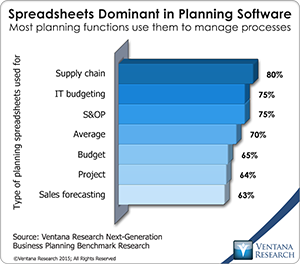Financial planning and analysis (FP&A) is one of the core functions of any finance department. Preparing a budget, measuring performance to financial objectives and forecasting the company’s financial position are three of the main tasks for the FP&A organization within Finance. A key challenge for today’s FP&A organization is increasing the business value and relevance of budgeting and planning. To do so, FP&A must transform the processes from a static, rear-view mirror approach to a forward-looking, action-oriented one. A continuous planning approach can achieve this objective. Continuous planning uses short, frequent planning or budgeting cycles to promote agility, coordination and accountability in operations. It includes establishing an ongoing dialogue among finance and line-of-business managers and executives to track current conditions as well as changes in objectives and priorities driven by markets and the business climate.
To manage planning in such a comprehensive way requires dedicated software that enables members of the FP&A organization to focus more of their time on developing actionable intelligence – not just on analysis of results. Dedicated software enables focusing on evolving market conditions as well as on modeling different scenarios to better anticipate changes or disruptions in markets or the competitive landscape. Such technology also enhances the quality of plans, forecasts and budgets because individuals can focus on planning itself, not on managing planning spreadsheets. Because iterative planning cycles can be much shorter, it’s possible to work through the potential impact of multiple different economic, market or competitive scenarios in the same time it would take to create a single scenario in a desktop spreadsheet system.
Centage’s Budget Maestro software supports the FP&A function. It is specifically intended to address the needs of small and midsize companies, which have limited financial and time resources to devote to administrative functions. The application automates and manages budgeting, planning, financial forecasting, consolidation, reporting, dashboards and analytics. The company’s latest release added enhanced capabilities for automating revenue- expense- and capacity planning to reduce the time needed to create and maintain models, The release expands Budget Maestro’s targeted verticals beyond business services to include manufacturing and health care.
Available for deployment on-premises or in the cloud on a subscription basis, Budget Maestro automates budgeting, addressing the shortcomings of spreadsheet-based processes for small and midsize businesses. Spreadsheets are the right choice for individual productivity or ad hoc analysis and reporting, but they are time-consuming and error-prone when used in repetitive, collaborative enterprise-wide processes such as budgeting and planning. Budgeting is essential for financial control, but time-strapped midsize companies will benefit by streamlining the process to reduce the time it takes to prepare a budget.
The Advanced Planning Edition of this product is aimed at the performance management requirements of midsize businesses that need more extensive planning and budgeting capabilities. The software automates collection of planning and budgeting data from individual business units and instant consolidation of that data into single enterprise data store. Any change at the business unit level is immediately reflected in the aggregated whole. The system can automate allocations and other calculations so that they are always accurate and consistent. The system is also capable of consolidating data from multiple general ledgers.
The Advanced Planning Edition also enables companies to do dynamic, integrated financial forecasting and planning. Integrated means bringing together the income statement, balance sheet and cash flow forecasts and plans. Integrated also means that as actual results are reflected in the system and the company makes changes to its plans, the cash flow and balance sheet forecasts are immediately updated. Finance organizations will be able to see the impact of those changes on their financial position. Dynamic means that it’s possible to do rapid scenario modeling across the three types of financial statements as well as do quick updates to refine models and explore the impacts of different scenarios. There are several benefits to this integrated approach. One is that it serves as a financial control by improving the certainty that the company will have sufficient cash to operate. If there are balance sheet covenants with lenders, it keeps executives focused on them so they have sufficient forward visibility if there’s a chance they will be broken. A second, related purpose is to be able to better forecast financing requirements, which in some companies can vary considerably by season or may be sensitive to specific business decisions. A third reason is to focus attention on balance sheet metrics that relate to productivity such as inventory turns and days sales outstanding. While it’s possible to do integrated financial forecasting and planning using spreadsheets, in practice it can take too long to be feasible.
Executives and managers can use the Analytics Maestro module to quickly view the system’s data from multiple perspectives – for example, by business unit, department, location, product or distribution channel, or any combination of these. The information can be presented to individuals in a variety of formats including dashboards, tabular reports that enable users to drill down to underlying details, presentation-style “board books” for senior executives, directors or financial institutions, or custom reports for specific types of users. Once designed, the system instantly incorporates the most current data into the reports.
Another optional add-on is Link Maestro, which automates the connection between a company’s enterprise systems and its software. These systems include software for accounting or ERP, human resources management, fixed assets or CRM. The connections enable fast and accurate incorporation of “actual” data to be able to report these numbers against budgeted or planned amounts. There are prebuilt connections available for several major ERP systems designed for small to midsize businesses, including Microsoft Dynamics, QuickBooks, Sage and Syspro. Automating the connection between enterprise systems is essential because it quickly and accurately synchronizes them with the budgeting, planning, consolidation and reporting applications.
Our benchmark research on next-generation business planning finds that two-thirds  (65%) of companies rely mainly on spreadsheets for their budgeting and financial planning. In midsize companies, the share is even higher (72%). Although spreadsheets appear to be free, they squander one of the most precious resources: time – the time spent collecting and consolidating multiple spreadsheets. Our spreadsheet research reveals that a majority (56%) of people find combining spreadsheets a usually or always arduous task, even those who have more than a decade of experience and spend most of their time working with them. The research also confirms that spreadsheets are error-prone. More than one-third (35%) of organizations routinely find errors in data, and one-fourth (26%) find errors in formulas. Finding and fixing errors is another reason why spreadsheets are time-consuming. In this research more than half (52%) of midsize and larger companies said that spreadsheets makes it difficult for them to manage their budget process.
(65%) of companies rely mainly on spreadsheets for their budgeting and financial planning. In midsize companies, the share is even higher (72%). Although spreadsheets appear to be free, they squander one of the most precious resources: time – the time spent collecting and consolidating multiple spreadsheets. Our spreadsheet research reveals that a majority (56%) of people find combining spreadsheets a usually or always arduous task, even those who have more than a decade of experience and spend most of their time working with them. The research also confirms that spreadsheets are error-prone. More than one-third (35%) of organizations routinely find errors in data, and one-fourth (26%) find errors in formulas. Finding and fixing errors is another reason why spreadsheets are time-consuming. In this research more than half (52%) of midsize and larger companies said that spreadsheets makes it difficult for them to manage their budget process.
Midsize companies, especially those with growth strategies, should invest in software that enables them to scale without having to add administrative head count. This advice also applies to small businesses that are approaching the midsize and need more formal planning and financial control capabilities but don’t want to add overhead. These organizations need to limit the time employees must spend on administrative chores in order to boost their productivity. It’s tempting to use spreadsheets for budgeting and planning because most people find them relatively straightforward to use for modeling and reporting. But by squandering valuable time they prevent companies from making better use their investments in business planning and reviews. Today, small and midsize businesses have software that is designed specifically for their requirements and budgets. I advise companies that are using spreadsheets for budgeting, planning, forecasting and reviews to consider using a dedicated application for these purposes. I recommend they assess Centage’s Budget Maestro software as part of the process.
Regards,
Robert Kugel
Senior Vice President Research










